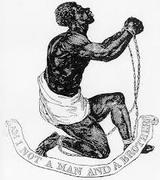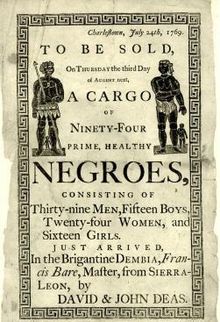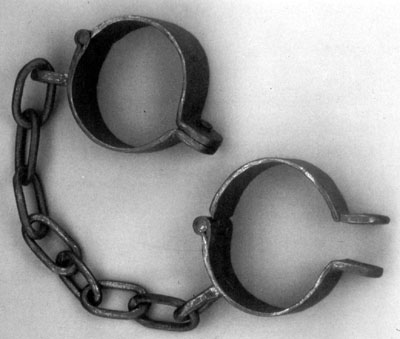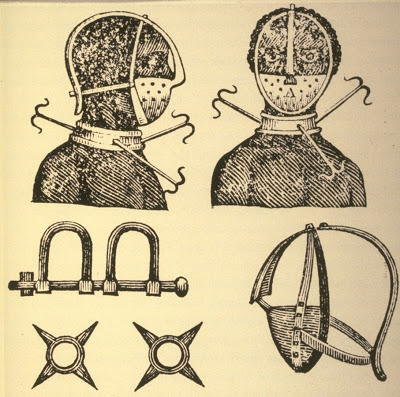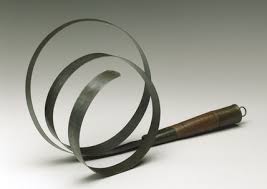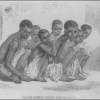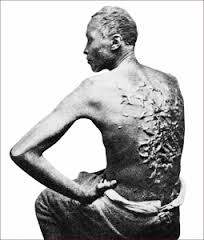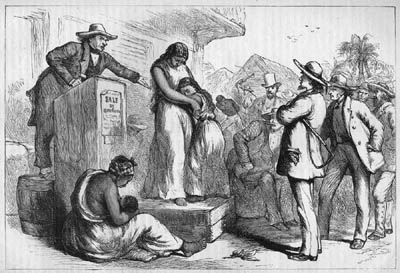"A slave is someone who is the property of another person. Slaves could be bought and sold, like real estate or animals." "Nobody has any right to make us a slave. We cannot make anyone else our slave" (Universal Declaration of Human Rights, Article 4, 1948). |
Often one of the most difficult things for students of history and historians to do is understand the ideas, actions, and experiences of people who lived in the past. Often, and as we have been discovering through our exploration into the transatlantic slave trade, the things people thought or did in the past can appear incompatible with the way many people think and act today. The study of slavery is a very good example of this difficulty and to help ourselves overcome this difficulty we will be investigating the main features of slavery and attempting to come up with our own definition of the term 'slavery'.
Activity 3: Slave Resistance - "What would you do?"

For this first activity we're going to briefly get into character and become another person for a few minutes. So I'd like you to imagine your answers to these questions in as much detail as possible.
I'd like you to imagine a slave. What do they look like? What is the slave doing? Where do they live? Are they living in any particular period of history?
Now I'd like you to imagine that you are that slave and begin the quiz by clicking the link below.
The Game PIN is on the on the board.
I'd like you to imagine a slave. What do they look like? What is the slave doing? Where do they live? Are they living in any particular period of history?
Now I'd like you to imagine that you are that slave and begin the quiz by clicking the link below.
The Game PIN is on the on the board.
The Experiences of Slaves
The next activity we are going to do will introduce us to the logistics of the slave trade through the experiences of slaves. To achieve this we are going to go on a bit of a gallery walk, that includes both images and videos.
It should be noted that the following sources (primary and secondary) focus on the dehumanising process of slavery that treated people as property and can be confronting. To get you all started I've selected four images to guide you through the dehumanising process of the slave trade that reflects peoples desire to own people for personal benefit and gain.
These images relate to different stages of the slave trade; capture, transport, auction, and branding. The images capture how the slaves were exploited and viewed as personal property. These images are valuable to us, as historians, because they demonstrate how those involved in the slave trade understood the value of human life and willingly participated in the exploitation of people for economic gains.
It should be noted that the following sources (primary and secondary) focus on the dehumanising process of slavery that treated people as property and can be confronting. To get you all started I've selected four images to guide you through the dehumanising process of the slave trade that reflects peoples desire to own people for personal benefit and gain.
These images relate to different stages of the slave trade; capture, transport, auction, and branding. The images capture how the slaves were exploited and viewed as personal property. These images are valuable to us, as historians, because they demonstrate how those involved in the slave trade understood the value of human life and willingly participated in the exploitation of people for economic gains.
Capture:
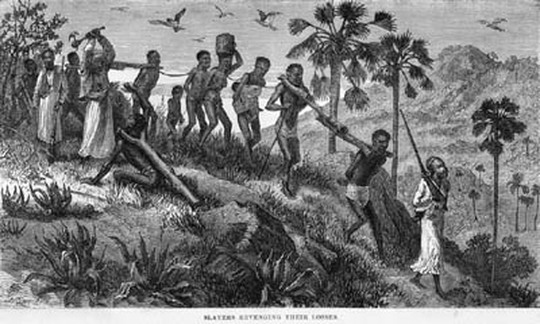 Source 2.2: The first image presents captured slaves being herded to the coast for transport.
Source 2.2: The first image presents captured slaves being herded to the coast for transport.
2.2: Often young Africans were captured whilst out hunting or were taken from their villages while their families were away. Unfortunately, the families of those captured often had no idea what happened to them. Those who were captured were herded into cages and loaded onto ships.
You can see how those involved treated slaves as personal property from the objects used to capture and restrain them. Often these objects, such as the long wooded neck chains, and weapons were used to subdue and dominate the slaves (see the figure in the left of the image about to strike a slave).
You can see how those involved treated slaves as personal property from the objects used to capture and restrain them. Often these objects, such as the long wooded neck chains, and weapons were used to subdue and dominate the slaves (see the figure in the left of the image about to strike a slave).
Transport:
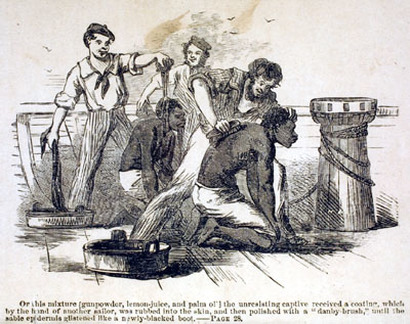 Source 2.3: The second image showcases the importance of presentation before the auction so as to fetch the best price.
Source 2.3: The second image showcases the importance of presentation before the auction so as to fetch the best price.
2.3: Due to the conditions under which slaves were transported to the Americas (recall the middle passage), the slaves were washed down like animals. The slaves' living quarters on the ship were leaky, ocean-going dungeons. Extremely hot in the summer and shivering cold in the winter. The slaves were left with little to no clothing, blankets, or bedding. Forced to lie in their own urine and excrement, the slaves were also provided with the bare minimum of food and fresh water to keep them alive, so that costs could be kept low and profits maximised.
Auction:
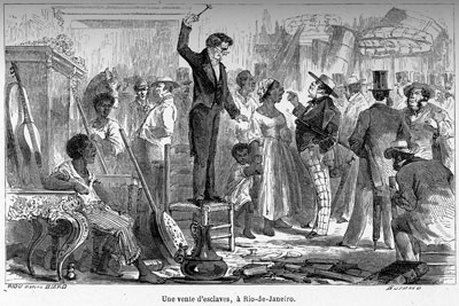 Source 2.4: The consistent flow of auctions continue the absence of human dignity and continues African submission as they are bought and sold to the highest bidder.
Source 2.4: The consistent flow of auctions continue the absence of human dignity and continues African submission as they are bought and sold to the highest bidder.
2.4: When the slaves arrived in the Americas they were unloaded and prepared for auction. Sores and wounds were covered in tar to conceal them. The slaves were then paraded around like animals before the potential buyers; who then examined the slaves. The interested buyers would thoroughly check the slaves mouth and teeth for illness or disease, feel their muscles and possibly comment upon the slaves ability as a potential breeder; much like someone buying a horse. This entire process was dehumanising and undignified.
Branding:
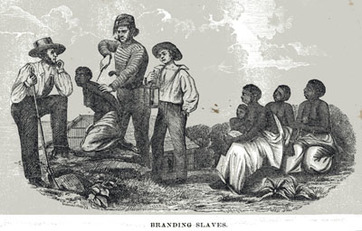 Source 2.5: The final image reflects how individuals want to make sure their assets are protected by “labeling them” with a brand – as if they were livestock.
Source 2.5: The final image reflects how individuals want to make sure their assets are protected by “labeling them” with a brand – as if they were livestock.
2.5: The dehumanising process is further reflected in the final image; the branding. Slaves had very little rights, and were considered to be property, not human beings, under the law. For example:
- Under the law, slaves could be bought and sold by their owners, and separated from their families
- Slaves were not allowed to own property, or leave their master's land without permission
- It was made illegal in places for slaves to learn to read or write
- A white person could kill a slave while punishing them without breaking the law.
Activity 4: Gallery Walk
On this gallery walk students will be viewing and analyzing the images and video from the gallery walk. As they explore the dehumanising process of the slave trade students will reflect upon the idea of the time; 'that it was acceptable to own people for personal benefit and gain'. Students will demonstrate how those involved understood the value of human life and how they willingly participated in the exploitation of people for economic gains.
To complete this activity, students must:
To complete this activity, students must:
- Look through the images and video clips (from the film Amistad) available below.
- Comment upon at least one video and three images. You may do this part of the activity in groups of up to four people. Make sure you take some informal notes and think about what the image or video is about, as well as it's theme and/or overall message.
- Open the graphic organiser through the link below. This will take you to a GoogleDocs page where we will compile the information we have gathered from the gallery walk.
- Then complete the reflection activity. Located at the end of the gallery walk.
|
Source 2.13:
Clip from the film Amistad, showing the treatment of slaves as they were boarded onto the slave ships. From Speilberg, Steven. "Amistad" 1997. |
Source 2.14: Clip from the film Amistad, showing slaves being thrown overboard during the middle passage. From Speilberg, Steven. "Amistad" 1997.
|
Source 2.15: The capture of slaves, movement to the ships, and living conditions during the middle passage. From Speilberg, Steven. "Amistad" 1997.
|
This button will take you to the GoogleDocs worksheet. Required for the Activity 4: Gallery Walk
|
|
